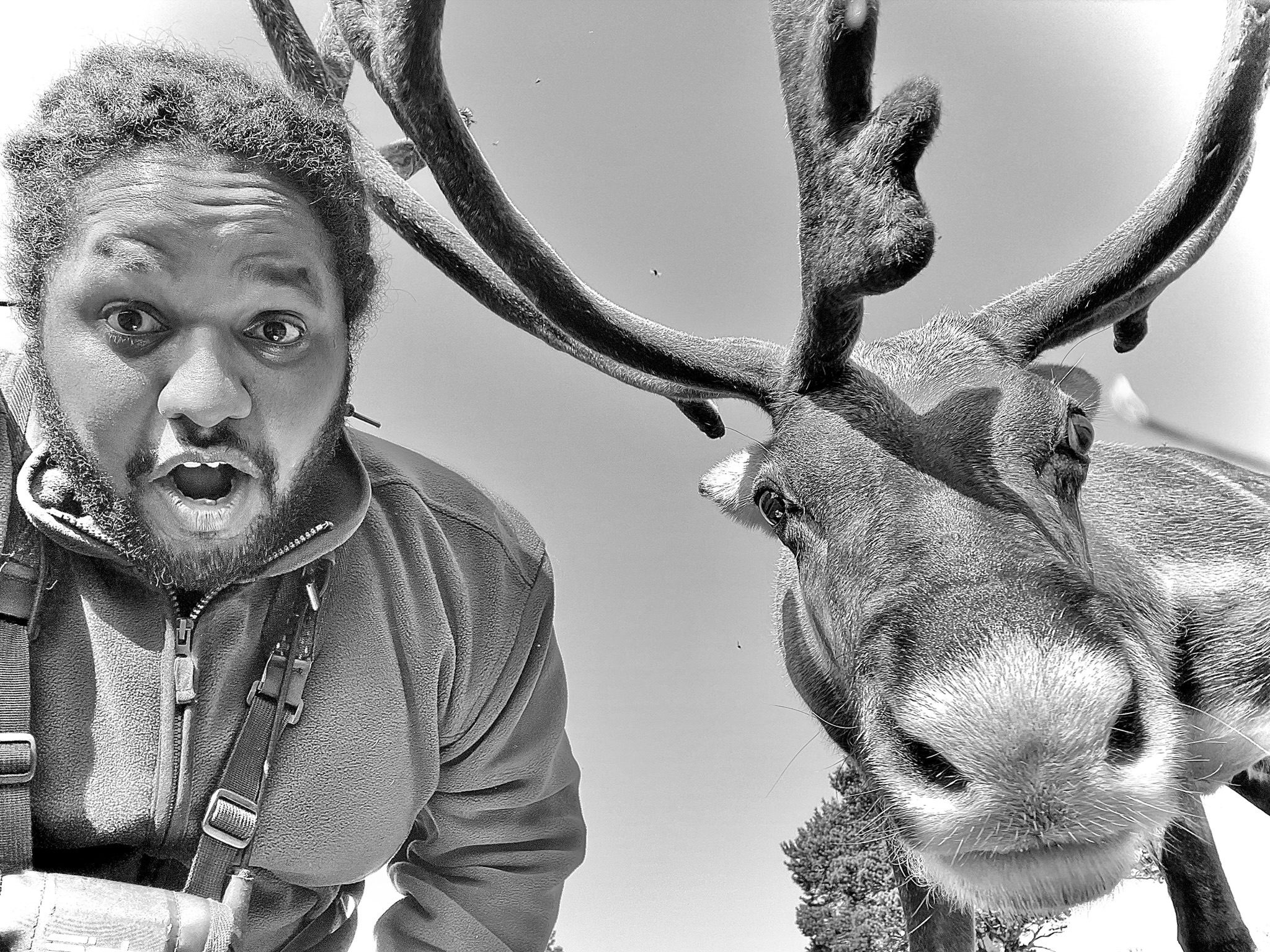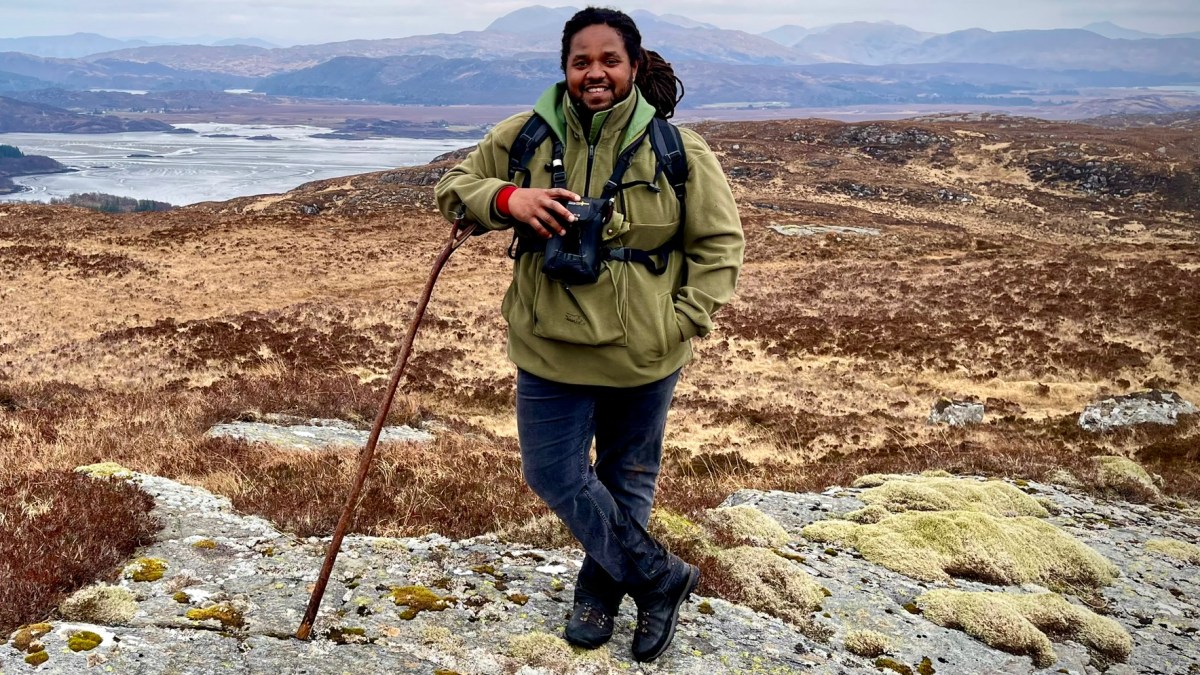I’ve lived on the Ardnamurchan peninsula on the west coast of Scotland for 17 years in an awesome little village of about 150 people. I’ve been in my house for ten years. Imagine a cottage in the Hebrides style; white with a dark blue background of sky. I was living in my Vauxhall seven-seater car for nine months when I first turned up. Then I moved into a farmer’s old caravan with no heating or running water, and then a caravan that did have water.
What was the most difficult thing about living in your car?
Not being spotted sleeping in the back by the locals. I was waking up at 8am, pretending I was going on the ferry. It turned out that they knew, they just never quizzed me. I didn’t have a fridge. I had showers at a local campsite. I’m sometimes asked if I find it tough being a black man in the countryside. I usually say that the wildlife doesn’t care. People were curious, not suspicious. They’d say, “What are you doing here?”
Does it feel like a luxury to now have your own house?
The sea is about 20 metres in front of the house. I see dolphins, orcas, eagles, red deer, otters. I felt like I’d conquered the world. I put in a wood-burning stove and had double-glazed windows. But I’d survived the west coast winters with double hoodies and duvets. It’s what we do as wildlife camera operators — go to remote places where there isn’t a Four Seasons hotel.

The Ardnamurchan peninsula
GETTY IMAGES
What do you love most about the area?
We all help each other out. We had a six-day power cut recently and I was connecting my neighbour’s fridges to my generator. If I don’t see my neighbour once a day walking past, I’ll check up on him. It’s the way that humanity should be living.
What’s your style in interiors?
Rustic and quirky. I hate buying new stuff. I make my own tables, stools and chopping boards from reclaimed wood. I love bonsai trees. I’ve got a telescope looking out the window to the bay. I have fairy lights around. There’s loads of collected bone fragments and skulls, and a bit of taxidermy.
• Read more expert advice on property, interiors and home improvement
How did you end up there?
A university friend knew of the area and showed me a picture of a stag taken there. I went up there immediately after uni and fell in love with it. All the wildlife cameramen that I look up to live in Scotland.
 How did you make a living?
How did you make a living?
I cut grass; I chopped logs for older folk; I cleaned houses; I worked as a ghillie; I did wedding and pet photography. All I needed was £50 a month. In the meantime I was getting a good database of footage and sending it to producers at the BBC. An incredible cameraman, Jesse Wilkinson, took me under his wing. I was his assistant for a number of years.
Where did you grow up?
In Sudan until I was eight. From the top of the house we could see the Nile. Our neighbour had a pet lion. And we had a pet monkey. As kids we’d get a box of sweets between us and he’d be sat in line ready for his lollipop like everyone else. We were living with my grandmother and I was surrounded by my aunties, uncles and cousins.
My parents are gynaecologists and, about 30 years ago, the Royal Society of Medicine asked them to help out in the NHS. They came over to see what the UK was like, then they sent for us. We ended up in Northampton. Everything was cold in the UK, which was a nice change from the heat in Sudan. I like the cold.

On location in the wild: “It’s what we do as wildlife camera operators, go where there isn’t a Four Seasons hotel”
What creatures do you most enjoy filming?
Anything that flies. Birds are hard to focus on, but I like filming difficult stuff. I’ve named all the eagles that I look after. The white-tailed pair are called Agatha and Laurence because they are like an old biddy couple. The golden eagle pair are called Lady and Assassin. He brings in foxes for her to feed the chicks.
What’s your routine when you’re not working?
I love a bit of woodworking. I chop five to seven tonnes of firewood a year. One day I want to build a cabin. I imagine myself as an old lumberjack living in the forest. I love walking the dog, Midge, a collie, which allows me to check out the otter holt and eagle perch. I share the dog with Chris and Amanda down the road — my “Scottish parents”, as my mum calls them. They look after me.

Yassin loves walking his dog, Midge; with a golden eagle chick
After winning Strictly in 2022, do you still practise your dance moves?
I don’t dance. I won because of my dyslexia. Jowita [Przystal, his Strictly partner] would dance the male role in front of me and, because I’ve got a photographic memory, I copied what she did. Doing Strictly has sprung me 20 years forward in my career. The only negative is that I can’t walk down the street with my hair in a messy bun because people want a selfie.

Yassin won Strictly in 2022
BBC
You’re a regular on CBeebies. What’s the best question kids ask?
It’s always, ‘Why do you have your hair so long?’ I say it’s because I ate all my fruit and vegetables, and Brussels sprouts make it even longer. But the most memorable question is, ‘Do you think we can save the world?’ As soon as a kid asks that, you know that the next generation is heading in the right direction to look after our planet.
Hamza’s Hidden Wild Isles is on BBC1 and BBC iPlayer

